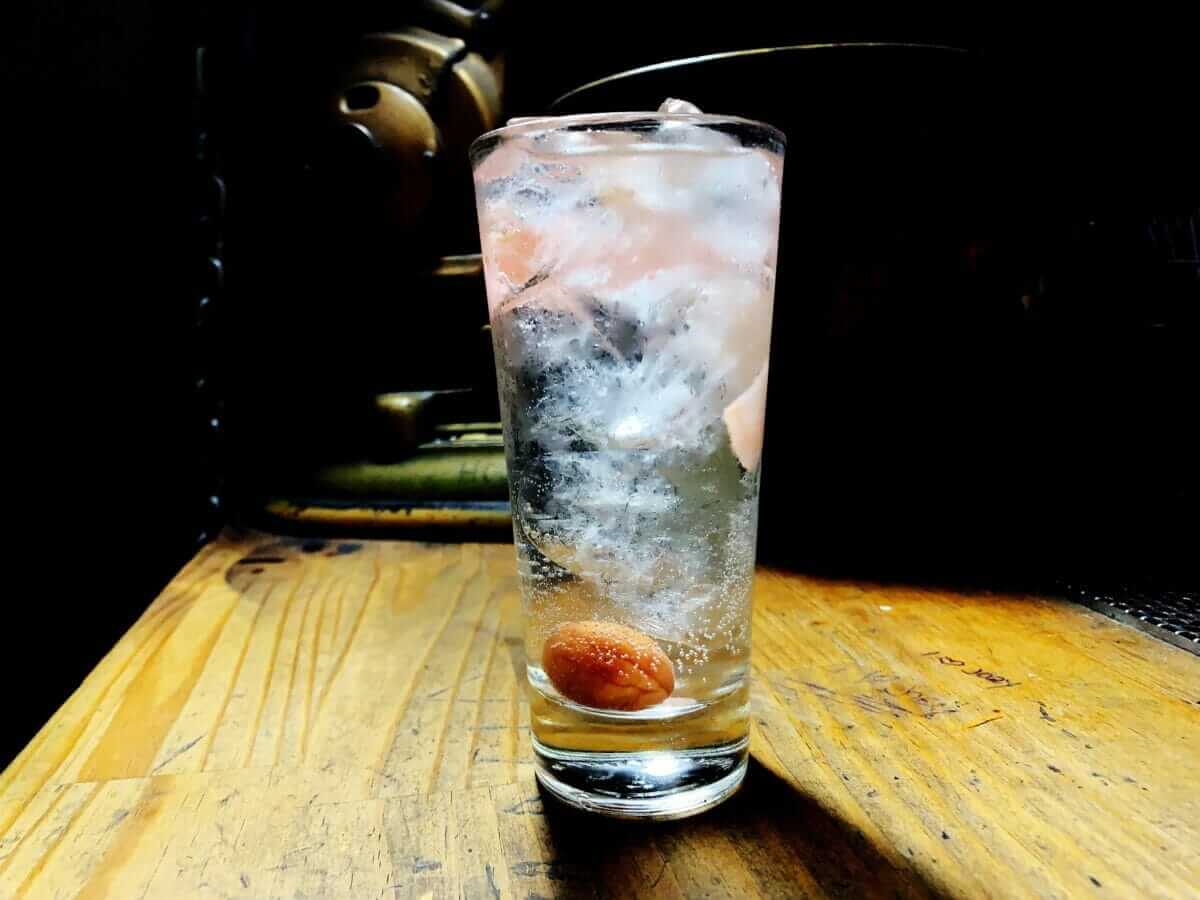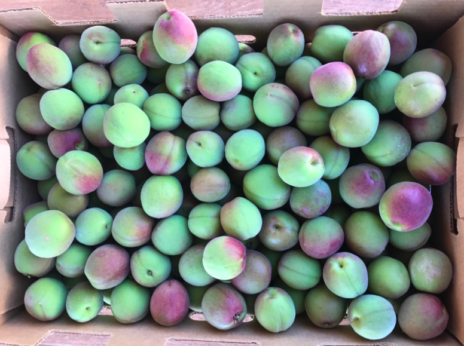How an Umeshu Grower and a California Distiller Paired up to Make a Baller of a Whiskey
It’s not just about Japanese plum wine anymore
How an Umeshu Grower and a California Distiller Paired up to Make a Baller of a Whiskey
It’s not just about Japanese plum wine anymore

Doesn’t this Japanese Gin and Tonic look refreshing?Aaron Polsky
With the history and prevalence of Japanese culture in California, it’s no surprise that everything from ramen to sushi to sake found its early American roots on the West Coast. Now, another staple of the Japanese culinary world is finding its home in California: ume, or Japanese sour plum. Ume is actually from Prunus mume, the Japanese apricot tree, but, flavorwise, the sour fruits are very different from plums and apricots and are not eaten fresh. Ume is either preserved, turned into salt-cured plum pickles known as umeboshi, or made into plum wine with shochu, known as umeshu.
“Ume can’t be eaten raw,” says Gen Yamamoto, the owner and bartender of his globally renowned, eponymous cocktail den in Tokyo. “It is too tart and sour and has a hard texture.”
The first time I came across ume in a cocktail was a revelatory experience at Gen Yamamoto, where he serves cocktail tasting flights in a minimalist environment designed to ensure that your full focus remains on the taste of precise libations made with seasonal fruits and Japanese spirits. The finale of a five-course cocktail tasting from Yamamoto was a hot drink with Yamazaki and ume, which together provided a peaceful, soul-soothing final note to the evening.
“Ume has its own strong tartness, acidity and flavors — there’s nothing to compare it to,” says Yamamoto. He uses the fruit in various ways to correspond with the seasons, including a preserved ume syrup that offers a refreshing note in summer or is served with its flowers in the springtime.
In fact, those flowers are actually the reason why at least one California farmer now has ume fruit available for harvesting. “I originally planted Prunus mume for cut flowers,” says Mike Madison of Yolo Press in the Sacramento Valley. “I eventually dropped that project, but the trees are still here. Now, my Korean and Japanese friends have discovered that I have them, and they come and harvest the fruit. They make umeboshi, as well as a variety of fermented drinks.”
Brian Murakami of Murakami Farms in Watsonville, California, is a third-generation strawberry farmer who also has a smattering of other plantings, including kiwifruit and ume. Just as Madison ended up with ume as a by-product of flowers, Murakami’s ume crop also began inadvertently. “My dad said that he planted the trees along the western edge of the strawberry fields to protect them from the wind,” says Murakami. “Growing ume has been more like a hobby to me.”
Now, beyond a growing customer base, he has found a passion for putting his ume to use. “I have been experimenting with how to make Japanese plum wine using different recipes for about five years, as a lot of the old traditions of making your own umeboshi and umeshu have been forgotten,” he says. “For consumers, the products are readily available at local oriental markets, but I don’t feel that they’re the same quality.”

Ume may still be a niche product, particularly among the abundance of California, but there are certainly other farmers to be found. Madison says that there’s a 60-acre Prunus mume orchard a few miles from his own, and Murakami knows of a 40-acre site in southern California that supplies the Los Angeles region.
Increasingly, today’s ume appeal is found in the drink world, with Murakami noting that a local distillery and brewery have expressed interest. At St. George Spirits in Alameda, California, the distillery uses barrels that hold self-made umeshu to impart a distinct flavor to Baller, a Japanese-style whiskey that it designed directly with highballs in mind. The team at St. George Spirits was introduced to an ume farmer in California from their friends at Rintaro, a San Francisco izakaya.
For master distiller Lance Winters, umeshu barrels affect whiskey in a similar way to sherry barrels, one of the workhorses of the Scotch world. “Sherry barrels provide some really lovely notes for single malt whiskey, with a touch of sweetness, some acidity and a nutty complexity,” he says. “We made small batches of umeshu in our lab and saw that it provided the same characteristics as sherry but from a different angle. The umeshu sweetness comes from the fruit itself, as well as the rock sugar used in the umeshu process, the acidity from the ume and the nuttiness from the shochu penetrating the stone of the fruit.”
Behind the bar, Aaron Polsky of Harvard & Stone in Hollywood, California, deploys umeshu in both stirred and carbonated drinks. “I find that the most prominent flavor of ume is that of the pit — it’s almondy, but it usually matures and blends with the base it’s been sitting in, as well as the flesh of the fruit,” he says. “Given the preparation, it’s really like a super-punch of salty, sweet, savory and bright.”
One drink on his current menu is the Heatseeker, which pairs umeshu with the punch of habanero, ginger and five-spice, as well as Bertoux Brandy, soda, apricot and lime. Elsewhere, he deploys umeshu with gin, Q Tonic Water and pickled ginger. “It’s a Japanese version of a Spanish gin tonic,” says Polsky. “Umeshu is packed with dense flavors, so a highly carbonated ginger beer or tonic like Q Indian Tonic Water helps bring the flavors to the forefront.”
California farm market devotees can keep their eyes peeled for ume from late May to early June, though you’ll be well advised to heed expert advice and avoid trying a fresh bite.
Follow us
This work is licensed under a Creative Commons Attribution-NoDerivatives 4.0 International License.
Want to republish a Modern Farmer story?
We are happy for Modern Farmer stories to be shared, and encourage you to republish our articles for your audience. When doing so, we ask that you follow these guidelines:
Please credit us and our writers
For the author byline, please use “Author Name, Modern Farmer.” At the top of our stories, if on the web, please include this text and link: “This story was originally published by Modern Farmer.”
Please make sure to include a link back to either our home page or the article URL.
At the bottom of the story, please include the following text:
“Modern Farmer is a nonprofit initiative dedicated to raising awareness and catalyzing action at the intersection of food, agriculture, and society. Read more at <link>Modern Farmer</link>.”
Use our widget
We’d like to be able to track our stories, so we ask that if you republish our content, you do so using our widget (located on the left hand side of the article). The HTML code has a built-in tracker that tells us the data and domain where the story was published, as well as view counts.
Check the image requirements
It’s your responsibility to confirm you're licensed to republish images in our articles. Some images, such as those from commercial providers, don't allow their images to be republished without permission or payment. Copyright terms are generally listed in the image caption and attribution. You are welcome to omit our images or substitute with your own. Charts and interactive graphics follow the same rules.
Don’t change too much. Or, ask us first.
Articles must be republished in their entirety. It’s okay to change references to time (“today” to “yesterday”) or location (“Iowa City, IA” to “here”). But please keep everything else the same.
If you feel strongly that a more material edit needs to be made, get in touch with us at [email protected]. We’re happy to discuss it with the original author, but we must have prior approval for changes before publication.
Special cases
Extracts. You may run the first few lines or paragraphs of the article and then say: “Read the full article at Modern Farmer” with a link back to the original article.
Quotes. You may quote authors provided you include a link back to the article URL.
Translations. These require writer approval. To inquire about translation of a Modern Farmer article, contact us at [email protected]
Signed consent / copyright release forms. These are not required, provided you are following these guidelines.
Print. Articles can be republished in print under these same rules, with the exception that you do not need to include the links.
Tag us
When sharing the story on social media, please tag us using the following: - Twitter (@ModFarm) - Facebook (@ModernFarmerMedia) - Instagram (@modfarm)
Use our content respectfully
Modern Farmer is a nonprofit and as such we share our content for free and in good faith in order to reach new audiences. Respectfully,
No selling ads against our stories. It’s okay to put our stories on pages with ads.
Don’t republish our material wholesale, or automatically; you need to select stories to be republished individually.
You have no rights to sell, license, syndicate, or otherwise represent yourself as the authorized owner of our material to any third parties. This means that you cannot actively publish or submit our work for syndication to third party platforms or apps like Apple News or Google News. We understand that publishers cannot fully control when certain third parties automatically summarize or crawl content from publishers’ own sites.
Keep in touch
We want to hear from you if you love Modern Farmer content, have a collaboration idea, or anything else to share. As a nonprofit outlet, we work in service of our community and are always open to comments, feedback, and ideas. Contact us at [email protected].by Jake Emen, Modern Farmer
December 13, 2018
Modern Farmer Weekly
Solutions Hub
Innovations, ideas and inspiration. Actionable solutions for a resilient food system.
ExploreExplore other topics
Share With Us
We want to hear from Modern Farmer readers who have thoughtful commentary, actionable solutions, or helpful ideas to share.
SubmitNecessary cookies are absolutely essential for the website to function properly. This category only includes cookies that ensures basic functionalities and security features of the website. These cookies do not store any personal information.
Any cookies that may not be particularly necessary for the website to function and are used specifically to collect user personal data via analytics, ads, other embedded contents are termed as non-necessary cookies.